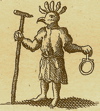 Must have been the champagne talking, not me; all the same, I do want to apologise to Wassmann Foundation director Jeff Wassmann for my wee hours post this morning inadvertently leaving open the possibility of Mr. Wassmann’s involvement with U.S. intelligence. He assures me unreservedly that his State Department stints in Beirut, Istanbul and Nairobi were all in the role of cultural attaché. Here’s our benefactor when we met in Paris a few weeks ago in an effort to finalise agreement for the repatriation to Germany of Johann Dieter Wassmann’s artwork after its 94-year absence.
Must have been the champagne talking, not me; all the same, I do want to apologise to Wassmann Foundation director Jeff Wassmann for my wee hours post this morning inadvertently leaving open the possibility of Mr. Wassmann’s involvement with U.S. intelligence. He assures me unreservedly that his State Department stints in Beirut, Istanbul and Nairobi were all in the role of cultural attaché. Here’s our benefactor when we met in Paris a few weeks ago in an effort to finalise agreement for the repatriation to Germany of Johann Dieter Wassmann’s artwork after its 94-year absence.
Tuesday, October 31, 2006
Not a spook, even on Hallowe'en
 Must have been the champagne talking, not me; all the same, I do want to apologise to Wassmann Foundation director Jeff Wassmann for my wee hours post this morning inadvertently leaving open the possibility of Mr. Wassmann’s involvement with U.S. intelligence. He assures me unreservedly that his State Department stints in Beirut, Istanbul and Nairobi were all in the role of cultural attaché. Here’s our benefactor when we met in Paris a few weeks ago in an effort to finalise agreement for the repatriation to Germany of Johann Dieter Wassmann’s artwork after its 94-year absence.
Must have been the champagne talking, not me; all the same, I do want to apologise to Wassmann Foundation director Jeff Wassmann for my wee hours post this morning inadvertently leaving open the possibility of Mr. Wassmann’s involvement with U.S. intelligence. He assures me unreservedly that his State Department stints in Beirut, Istanbul and Nairobi were all in the role of cultural attaché. Here’s our benefactor when we met in Paris a few weeks ago in an effort to finalise agreement for the repatriation to Germany of Johann Dieter Wassmann’s artwork after its 94-year absence.
Opening night at the Leipzig Film Festival
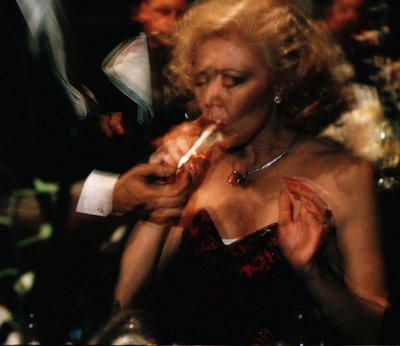 Pictured: Countess Eva-Maria von Schönburg-Glauchau at Café Spizz.
Pictured: Countess Eva-Maria von Schönburg-Glauchau at Café Spizz.Leipzig’s glitterati, and then some, gathered last night at the Museum der bildenden Künste for opening celebrations of the city’s annual film festival, Das Internationale Leipziger Festival für Dokumentar- und Animationsfilm, running until 5 November (see link below). Although a poor cousin to the Berlin Film Festival, in focusing on the genres of documentary and animation, the Leipzig festival has found its niche.
As the reluctant subject of THE FOUNDATION, a documentary film currently in production by Australian filmmaker Richard Moore, I’ve been busily booking out the festival season to see what I’m getting myself into.
The evening kicked off with a screening of three powerful films, most notably the short TOWER BAWHER by the Bulgarian digital animator Theodore Usher, who currently lives in Canada. Featuring the score “Time Forward” by Georgy Sviridov, the work sees Russian constructivism deconstructed by the 2nd law of thermodynamics, as entropy rules Usher's universe of line, volume, colour and form.
To the festival organisers' credit, more women directors than ever are represented, but the Eurocentric focus of the directors chosen (if not their subject matter) remains a disappointment.
The usual drinks and chatter followed, with a gracious welcome from mayor Burkhard Junj, before the crowd sprawled out into the chill in search of late-night venues on a sleepy Leipzig Monday. A few years beyond raving, I made my way with the international, but mostly European, contingent to Café Spizz, a local jazz club.
After a grilling over MuseumZeitraum’s American financial backing and a round of questioning over rumours of Wassmann Foundation director Jeff Wassmann’s intelligence connections (yes, I believe Mr. Wassmann was formerly with the U.S. Department of State and has some tie to the Kennedy clan; no, he isn’t a spook, to the best of my knowledge), the evening eased into the usual late-night banter covering the war in Iraq, Prof Dr Angela Dorothea Merkel, the sorry state of film funding and, of course, to what extent our Leipzig School painters have ‘gone Faust’.
With first light breaking and the birds a-chirping, I'll say good night for now and keep you posted as the week progresses.
Thursday, October 26, 2006
An Incomplete History of the Art of Funerary Violin
 A special thanks to Prairie Lights bookseller Jim Harris for sending along an advance copy of Rohan Kriwaczek’s AN INCOMPLETE HISTORY OF THE ART OF FUNERARY VIOLIN. As many of you may know along with Mr. Harris, Johann Dieter Wassmann’s brother, the composer Hugo Wassmann, was active in the Lutheran wing of Leipzig’s Guild of Funerary Violinists in the 1890s. Hugo’s ultimate falling out with the Guild came in 1901 over his efforts to introduce the saxophone to funerary rights, a practice that failed in Leipzig, but would eventually take hold in the city of New Orleans with great success, although not among Lutherans. Meanwhile, the art of funerary violin all but died out in Europe by 1915.
A special thanks to Prairie Lights bookseller Jim Harris for sending along an advance copy of Rohan Kriwaczek’s AN INCOMPLETE HISTORY OF THE ART OF FUNERARY VIOLIN. As many of you may know along with Mr. Harris, Johann Dieter Wassmann’s brother, the composer Hugo Wassmann, was active in the Lutheran wing of Leipzig’s Guild of Funerary Violinists in the 1890s. Hugo’s ultimate falling out with the Guild came in 1901 over his efforts to introduce the saxophone to funerary rights, a practice that failed in Leipzig, but would eventually take hold in the city of New Orleans with great success, although not among Lutherans. Meanwhile, the art of funerary violin all but died out in Europe by 1915.Here’s a short excerpt from the book’s dust-jacket, and a link if you’re interested in purchasing this intriguing work:
“During the Reformation a new musical form developed to replace Catholic funerary ritual. A solo violinist became central to the conduct of the Protestant funeral. Despite its enormous influence on classical music generally and on the Romantic Movement in particular, this music has almost entirely vanished. In a series of ‘funerary purges’, the violinists were driven into silence or clandestine activity.
“This is a music that, despite all attempts at suppression, has haunted Europe’s collective unconscious for more than a century. Now Rohan Kriwaczek reveals its incredible history. He acts in the hope that by remembering the Guild we realize afresh what our music once was, and what it might be once again.”
Wednesday, October 25, 2006
Wednesday Archive #6 - The birth of the modern

The general consensus among academics dates the development of an early modern aesthetic in Johann Dieter Wassmann’s work to 1889. Beyond the presence of modernist concerns in his assemblage works, and later photography, his awareness of the changing nature of art can clearly be seen in his collected ephemera, currently held in the archives of the Wassmann Foundation, Washington, D.C.
The idea that innate images and objects may store substantial metaphorical content is as old as art itself, but it was the modern era that saw their removal from historical context, with essence alone left to both represent and raise doubts about traditional linkages. Johann’s very process of gathering material, either for future works or purely for enjoyment, involved just such a process of removal, stripping away historical ties, opening up potential new meaning for a modern world.
The engraving above is one such image, conjuring a wealth of surreptitious possibilities. Researchers at the foundation have since shown the engraving to be cut from E. Atkinson’s NATURAL PHILOSOPHY (London: Longmans, Green and Co., 1887), a translation of A. Ganot's COURS ÉLÉMENTAIRE DE PHYSIQUE, one of several editions Johann owned. The image is, however, nothing more than a demonstration of concave mirrors, but in clipping it from the surrounds of its purpose, he has liberated it, and the viewer, from the historicism of its creation.
Monday, October 23, 2006
Park Sanssouci 1897
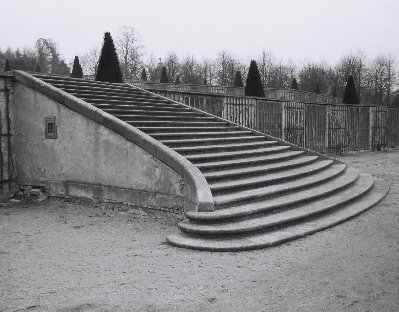
JOHANN DIETER WASSMANN, Weinbergterrassen, Park Sanssouci, Potsdam, 1897. Albumen silver print, 18 x 23 cm, WF 748030.
As a native Berliner, the arrival of autumn has, since the fall of the wall, beckoned a short trip to Potsdam and a Saturday stroll through the delicious gardens of Sanssouci. This autumn proved no exception, a weekend in Berlin catching shows and openings providing the perfect opportunity to escape to the park’s wonderfully Rococo decadence. The 18th century summer residence of Frederick the Great, Sanssouci is more villa than palace, full of quiet moments of intimacy and folly.
Johann Dieter Wassmann was no less fond of making the trek, although never in summer. Autumn and early spring were his preferred seasons for taking in the brooding melancholy of this most cultured pearl.
Friday, October 20, 2006
The moons of Galileo
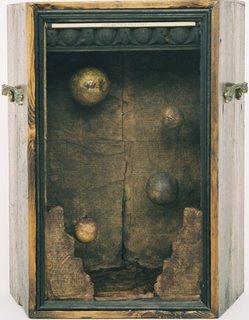 "I should disclose and publish to the world the occasion of discovering and observing four Planets, never seen from the beginning of the world up to our own times, their positions, and the observations made during the last two months about their movements and their changes of magnitude; and I summon all astronomers to apply themselves to examine and determine their periodic times, which it has not been permitted me to achieve up to this day . . . On the 7th day of January in the present year, 1610, in the first hour of the following night, when I was viewing the constellations of the heavons through a telescope, the planet Jupiter presented itself to my view, and as I had prepared for myself a very excellent instrument, I noticed a circumstance which I had never been able to notice before, namely that three little stars, small but very bright, were near the planet; and although I believed them to belong to a number of the fixed stars, yet they made me somewhat wonder, because they seemed to be arranged exactly in a straight line, parallel to the ecliptic, and to be brighter than the rest of the stars, equal to them in magnitude . . .When on January 8th, led by some fatality, I turned again to look at the same part of the heavens, I found a very different state of things, for there were three little stars all west of Jupiter, and nearer together than on the previous night.
"I should disclose and publish to the world the occasion of discovering and observing four Planets, never seen from the beginning of the world up to our own times, their positions, and the observations made during the last two months about their movements and their changes of magnitude; and I summon all astronomers to apply themselves to examine and determine their periodic times, which it has not been permitted me to achieve up to this day . . . On the 7th day of January in the present year, 1610, in the first hour of the following night, when I was viewing the constellations of the heavons through a telescope, the planet Jupiter presented itself to my view, and as I had prepared for myself a very excellent instrument, I noticed a circumstance which I had never been able to notice before, namely that three little stars, small but very bright, were near the planet; and although I believed them to belong to a number of the fixed stars, yet they made me somewhat wonder, because they seemed to be arranged exactly in a straight line, parallel to the ecliptic, and to be brighter than the rest of the stars, equal to them in magnitude . . .When on January 8th, led by some fatality, I turned again to look at the same part of the heavens, I found a very different state of things, for there were three little stars all west of Jupiter, and nearer together than on the previous night."I therefore concluded, and decided unhesitatingly, that there are three stars in the heavens moving about Jupiter, as Venus and Mercury around the Sun; which was at length established as clear as daylight by numerous other subsequent observations. These observations also established that there are not only three, but four, erratic sidereal bodies performing their revolutions around Jupiter."
Galileo Galilei, SIDEREUS NUNCIUS, March 1610.
This week I’ve been looking at Johann Dieter Wassmann’s little-known 33-piece suite “Der Ring des Nibelunge,” 1896. Each work in this remarkable ensemble takes the form of a pine box, shaped as an isosceles trapezoid, with the glass front constituting the smaller of the two parallel planes. When assembled in three groups, 11 boxes are positioned to form a circle, with the fronts facing inward, toward one another, rather than outward toward the viewer.
The last of these three groups shows Johann’s strong fascination with an increasingly reductive notion of pure space, space nearing the void of deep space itself. In each of these boxes the sole structural element is one or more planetary forms, but rather than being highly descriptive, these elements are depicted as nothing more than aged brown balls, leaving the focus of our attention on the void itself. The inner surface of these boxes is lined with heavily-stained text, in the case of the work above text from a 19th century French-German dictionary. “The Moons of Galileo” is sufficiently descriptive to allow us to identify the individual moons – from top to bottom, Ganymede, Europa, Callisto and Io – but grouped alone, without Jupiter, they are purposely lost at sea.
This metaphor of complete and possibly abject isolation – the isolation not of the void, but of the individual within the void – came to dominate much of Johann’s output in the remaining 18 months of his life.
Thursday, October 19, 2006
The birth of the surreal
 As spring 1896 moved on to summer, Johann Dieter Wassmann continued work on his seminal 33-piece “Der Ring des Nibelunge” (Ring Cycle – please see my previous post for background). During this period the tone of the works turned increasingly playful, covering a range of interests, until a sudden shift arrived with autumn, his final 11 works in the series reaching a dark and deeply introspective spatial void, which I will discuss in my next post. Prior to the void, however, came “The Heavens”, shown above, in which a bird’s nest sprouts not baby birds, but five doll's legs in yet another nod to the Dadaists and Surrealists to come. As cheerful as it is perverse, it brings to mind the eerie 1930s constructions of Hans Bellmer.
As spring 1896 moved on to summer, Johann Dieter Wassmann continued work on his seminal 33-piece “Der Ring des Nibelunge” (Ring Cycle – please see my previous post for background). During this period the tone of the works turned increasingly playful, covering a range of interests, until a sudden shift arrived with autumn, his final 11 works in the series reaching a dark and deeply introspective spatial void, which I will discuss in my next post. Prior to the void, however, came “The Heavens”, shown above, in which a bird’s nest sprouts not baby birds, but five doll's legs in yet another nod to the Dadaists and Surrealists to come. As cheerful as it is perverse, it brings to mind the eerie 1930s constructions of Hans Bellmer.
Tuesday, October 17, 2006
Privilege of Priests
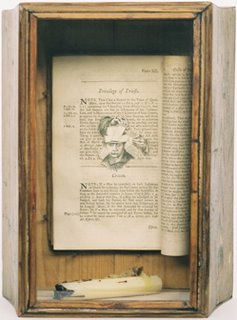 Following on from my last post, “Of the Stealing of Women,” I thought it appropriate to introduce a companion piece Johann Dieter Wassmann also built in the spring of 1896. Titled “Privilege of Priests,” the construction again begins with an early 18th century law text, this time open to a case law page entitled, Privilege of Priests. But unlike “Of the Stealing of Women,” he removes it from its context, by a adding an engraving of a small boy bandaged from the same mid-19th century medical text as the bandaged women’s torso in “Of the Stealing of Women.” In doing so, the assemblage immediately and painfully evokes the broken children left behind by the unspoken and widely accepted practice of sexual abuse followed for centuries by the Catholic Church. While Johann could best be described as a lapsed Lutheran, we was adamantly anti-Catholic and more than willing to challenge the hypocrisy of the church in works such as this.
Following on from my last post, “Of the Stealing of Women,” I thought it appropriate to introduce a companion piece Johann Dieter Wassmann also built in the spring of 1896. Titled “Privilege of Priests,” the construction again begins with an early 18th century law text, this time open to a case law page entitled, Privilege of Priests. But unlike “Of the Stealing of Women,” he removes it from its context, by a adding an engraving of a small boy bandaged from the same mid-19th century medical text as the bandaged women’s torso in “Of the Stealing of Women.” In doing so, the assemblage immediately and painfully evokes the broken children left behind by the unspoken and widely accepted practice of sexual abuse followed for centuries by the Catholic Church. While Johann could best be described as a lapsed Lutheran, we was adamantly anti-Catholic and more than willing to challenge the hypocrisy of the church in works such as this.Both of these works are drawn from a suite of 33 similarly shaped pine boxes Johann called “Der Ring des Nibelunge,” so-named after Richard Wagner’s “Ring Cycle”. In Johann’s case, the 33 works are divided into 3 groups, with 11 boxes in each. These groups form perfect rings when installed with their glass front facing inward, so the works uniquely face and interact with one another, rather than outward toward the viewer. Johann purchased three round pine champagne tables in the summer of 1896 on which to display the works, but they were never publicly shown in his lifetime. Remarkably “Der Ring des Nibelunge” still has never been displayed as a complete group in a public institution, but will certainly be proudly on display when MuseumZeitraum Leipzig opens in July 2008.
Thursday, October 12, 2006
Of the Stealing of Women
 Dada and Surrealism were still years away when Johann Dieter Wassmann struck out with this monumental, if misunderstood, work, “Of the Stealing of Women” 1896. Never before published or exhibited, the work merges an early 18th century English case-law text, open to a page describing the (limited) rights of women from being, yes, that’s right, stolen, with a medical engraving of mid-19th century bandaging practices, all linked by a harmony of violin pegs and tailpiece. In his notes on the work, Johann enthusiastically describes the piece in terms that we now might read as empowerment and liberation, closing with an enigmatic quote from his beloved muse, Goethe: ‘Man sieht nur, was man weiss.’ One sees only what one knows. Some critics have hesitated at themes they (mis)read as bondage and repression, with one Australian curator going so far as to have the work removed from the exhibition BLEEDING NAPOLEON at the 2003 Melbourne International Arts Festival (see link below).
Dada and Surrealism were still years away when Johann Dieter Wassmann struck out with this monumental, if misunderstood, work, “Of the Stealing of Women” 1896. Never before published or exhibited, the work merges an early 18th century English case-law text, open to a page describing the (limited) rights of women from being, yes, that’s right, stolen, with a medical engraving of mid-19th century bandaging practices, all linked by a harmony of violin pegs and tailpiece. In his notes on the work, Johann enthusiastically describes the piece in terms that we now might read as empowerment and liberation, closing with an enigmatic quote from his beloved muse, Goethe: ‘Man sieht nur, was man weiss.’ One sees only what one knows. Some critics have hesitated at themes they (mis)read as bondage and repression, with one Australian curator going so far as to have the work removed from the exhibition BLEEDING NAPOLEON at the 2003 Melbourne International Arts Festival (see link below). Personally, I believe the work can be read as a nod to the rising sentiment across Europe in support of women's suffrage. Three years earlier, in 1893, New Zealand was the first country to introduce universal suffrage, generating headlines world-wide. The use of an English case-law book would suggest some reference to the British empire here. The image of a woman bandaged suggests a play on the word suffrage. Violin pegs are, of course, necessary to tune the instrument, implying an adjustment or refinement of the social politic to enhance the role of women in 19th century society.
Whatever its inner meaning, the work stands as a significant precursor to the explosive power Dada and Surrealism would have on the course of 20th century modernism.
Wednesday, October 04, 2006
The case of Mlle Marie-Madeleine Lafort Wednesday Archive #05
 Amonst the many strange and wonderful dossiers gathered by Johann Dieter Wassmann is an extensive file he kept on the case of Mlle Marie-Madeleine Lafort, a French hermaphrodite whose physical peculiarities were widely studied and published in the mid-19th century (pictured at left in an 1872 engraving by L. Chapon from the collection of The Wassmann Foundation, Washington, D.C.) Johann's fascination was less voyeuristic than it might at first appear. In the 1890s he became intrigued with the growing debate concerning sexual identity and the determinants that come into play in making us male or female. The case of Mlle Lafort brought into doubt many of society's preconceived notions in this realm.
Amonst the many strange and wonderful dossiers gathered by Johann Dieter Wassmann is an extensive file he kept on the case of Mlle Marie-Madeleine Lafort, a French hermaphrodite whose physical peculiarities were widely studied and published in the mid-19th century (pictured at left in an 1872 engraving by L. Chapon from the collection of The Wassmann Foundation, Washington, D.C.) Johann's fascination was less voyeuristic than it might at first appear. In the 1890s he became intrigued with the growing debate concerning sexual identity and the determinants that come into play in making us male or female. The case of Mlle Lafort brought into doubt many of society's preconceived notions in this realm. The term hermaphrodite has its origins in Greek mythology, named after the son of Hermes and Aphrodite who became joined in one body with the nymph Salmacis. Now known as intersex, this condition of ambiguous genitalia is far more common than is generally assumed, with even the most conservative estimates putting the incidence at 1 in 4500 births. Until the 20th century, the condition was left as is, with parents free to raise the child as they saw fit, but with the rise of modern medicine the fate of the child to become a boy or a girl was most often determined surgically by doctors shortly after birth. For a more enlightened view on the condition and how best to consider the needs of the child, here's a link to Elizabeth Weil's recent piece "What if It’s (Sort of) a Boy and (Sort of) a Girl?" in The New York Times Magazine.
Subscribe to:
Comments (Atom)
